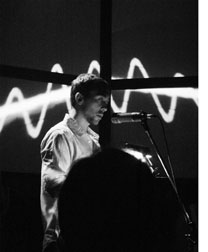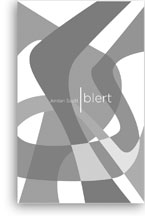
A review of the Poetry Performance of Jordan Scott and the Sounds of the Element Choir, Thursday, May 21, 2009 at the Music Gallery in Toronto, Canada.
There was a mystical quality to Jordan Scott’s performance at the Music Gallery in May of this year. The venue, St. George the Martyr Anglican Church, was built in 1844. Although partly burned down in the 1950s, the church retains its stone structure and stained glass, reflecting its original purpose as a place of worship. This is appropriate for the shows put on by the Music Gallery, experimental and unconventional performances that encourage thoughtful reflection in the listener.

Prior to the show, people milled about in the cloistered garden and hall, beverages were served and an excited buzz pervaded the air as people waited for the show to start. It looked like a full house.
For the first part of the performance, Jordan stood in front of a screen that acted as a sound monitor, giving his voice a visual aspect as it was transformed into a wave pattern. His strong voice and clear articulation, and the effect of his imaginative and oblique poetry, captured and held everybody’s attention.
Poetry, unlike prose, is ideally meant to be heard aloud, not read silently; Jordan uses this to full advantage. Here, stuttering exists not as something to be avoided or remedied, but as an integral part of the text and delivery.
In the Author’s note of his book, Jordan states that he writes poetry to be as difficult for him to speak as possible. Indeed, the phrases he has constructed are a stutterer’s nightmare. His linguistic acrobatics boggle the ears, the juxtapositions and imagery are at once playful and distressing, venturing deep into the torment of disfluency and the feeling of a crippling loss of control that accompanies it.
Phrases like “scalloped throats”, “my mandible rustle a quiet tectonic”, “the panicked pharynx ratches the tale,” the command, “now open your mouth and speak” and the eloquent “my mouth drew the swallow’s panic”, describe the struggle he, and other PWS, undergo in the act of speaking.
For the second part of the performance, Jordan moved to the nave side of the church to join the Elemental Choir, an experimental vocal group. Like a Greek Chorus, they responded to and complimented Jordan’s own vocalizings with their other-worldly soundtrack. The effect was intriguing and dramatic. The choir sounded at times like animals or alien trance music, and at others like the weather, embodying the noise of the wind or rain. The extraordinary use of the voice – the crescendo, the wail and the gasp, the uptake of breath – served as auditory illustrations to Jordan’s metaphorical utterances and delivery.
Jordan’s choice of words and imagery reflects his obsession with the cerebral process of language and its relationship to the physical aspect of speech. According to the poet, this dual nature of self-expression is deeply felt in the faltering utterances of the person who stutters. He calls stuttering a “language disturbance”, making a crucial distinction between speech and language. As he states in the Author’s note of his book, “a stutterer’s interaction with language is different” from the non-stutterer, an observation that has fueled his talent as a writer and poet. The suspended moment between thought and utterance, intensified in the stuttering experience, has colossal psychic meaning. Yet he claims, “I will not imagine myself as a giant mouth.”
It is certainly unique for a person who stutters to describe his impediment with such penetrating eloquence, to elucidate his struggle using verbal speech, the very thing that shackles him, as his tool to do so.
Jordan’s poetry is a sword raised against the tyranny of his stuttering – showing no mercy, he bends the spoken word to his will, and emerges victorious.
